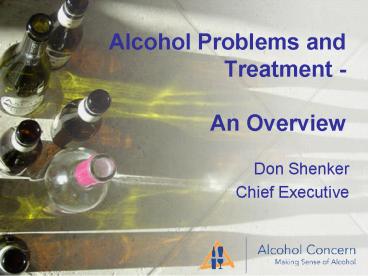Alcohol Problems and Treatment - An Overview - PowerPoint PPT Presentation
1 / 17
Title:
Alcohol Problems and Treatment - An Overview
Description:
Alcohol Problems and ... About 2m children affected by parental alcohol problem Between 30-60% child ... chd, stroke, rising trend of liver disease, ... – PowerPoint PPT presentation
Number of Views:177
Avg rating:3.0/5.0
Title: Alcohol Problems and Treatment - An Overview
1
Alcohol Problems and Treatment - An Overview
- Don Shenker
- Chief Executive
2
Impact of alcohol misuse
3
Impact of alcohol dependency on health services
- 1 in 4 acute male admissions are alcohol related
- In 11 of cases, alcohol is the main cause of
mens high blood pressure - Alcohol is a factor in 48 of all violent crime
- At peak times 7 out of 10 people attending AE
have alcohol related problems - Alcohol misuse costs the NHS 2.7 billion a year
and totals 25Bn pa
4
Daily guidelines for sensible drinking adults
- Recommended sensible drinking
- 2-3 units or less for women
- 3-4 units or less for men
- CMO recommends no alcohol for under 15s
- Department of Health
5
Units of alcohol
- 1 unit half pint beer (3.5 alcohol)
- 1 unit single spirits (25ml _at_ 40 alcohol)
- 1 unit 1 glass wine (125 ml _at_ 8 alcohol)
- But these are now quite rare!
6
Government Categories
- Lower risk drinkers (who are at a low risk of
alcohol-related illness) are defined as - Men who dont regularly drink more than 3 to 4
units a day - Women who dont regularly drink more than 2 to 3
units a day - Increasing risk drinkers (who are at an
increasing risk of alcohol-related illness) are
defined as - Men who regularly drink more than 3 to 4 units a
day but less than the higher risk levels - Women who regularly drink more than 2 to 3 units
a day but less than the higher risk levels. - Higher risk drinkers (who have high risk of
alcohol-related illness) are defined as - Men who regularly drink more than 8 units a day
or more than 50 units of alcohol per week - Women who regularly drink more than 6 units a day
or more than 35 units of alcohol per week
7
(No Transcript)
8
Related health conditions
- Chronic Disorders
- Gastrointestinal
- Cardiovascular
- Neuropsychiatric conditions
- Cancers
- Admissions34,000-91,000
- Acute Disorders
- Acute Toxic Effects
- Accidents and assaults
- Self-inflicted injuries
- Admissions40,000-60,000
- Sources DoH (1995), Gutjahr et al (2001),
Britton and McPherson (2001)
9
Alcohol related crime
- Estimated 1.2m incidents of alcohol related
violence - 80,000 arrests for drunk and disorderly
- 19,000 sexual assaults related to alcohol
- 85,000 cases of drink driving
- 360,000 victims of alcohol related domestic
violence Source Strategy Unit Interim
Analysis (2003)
10
Alcohol and the family
- Relationship breakdown
- Domestic violence and aggression
- Health impacts
- Poor parenting
- Unsafe sex
- Marriages twice as likely to end in divorce
- 1/3 of divorce petitions (W.H.O.)
- About 2m children affected by parental alcohol
problem - Between 30-60 child protection cases
11
FAST
- 1. MEN How often do you have EIGHT or more
drinks on one occasion? - WOMEN How often do you have SIX or more drinks
on one occasion? - 2. How often during the last year have you been
unable to remember what happened the night before
because you had been drinking? - 3. How often during the last year have you failed
to do what was normally expected of you because
of drinking? - 4. In the last year has a relative or friend, or
a doctor or other health worker been concerned
about your drinking or suggested you cut down?
12
Cycle of change (Prochaska DiClemente 1986)
13
Elements of brief adviceFRAMES
- Feedback about risks of substance use
- Responsibility placed on client to change
- Advice to cut down / abstain etc.
- Menu of options and choices
- Empathic approach
- Self-efficacy using a non-confrontational
counselling style which encourages reinforces
clients strengths
14
Stepped Care Approach
Aimed at individuals with a high level of
presenting need. Inpatient detox and
stabilisation, residential rehab or
residential crisis intervention
Tier 4 ab
Solely for misusers in structured programmes of
care
Treatment services
Tier 3
Care planned counselling
Provide accessible alcohol specialist services
for a wide range of alcohol misusers
Self-help groups
Assertive Outreach
Tier 2
Drop in services
Outreach
Specific advice information services
Police/CSO
Services that work with a wide range of clients
Tier 1
Housing
AE/Walk in Centre/Minor injuries
Primary Care
15
Types of treatment
- Advice and information (Tier 2)
- Self-help groups (Tier 2)
- Care planning counselling (Tier 3)
- Structured day programmes (Tier 3)
- Community detoxification (Tier 3)
- Inpatient treatment (Tier 4)
- Residential rehabilitation services (Tier 4)
16
(No Transcript)
17
Thank You
dshenker_at_alcoholconcern.org.uk Tel. 020 7264 0510
- www.alcoholconcern.org.uk































